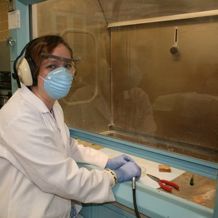Featured Fieldwork
HEEAL
Historical Ecology in East Africa
About Paul's Research
Concentrating primarily on the last 500 years, the sub-projects are exploring the intensification of herding and the emergence of specialised hunting (Paul Lane); the environmental and social consequences of intensive agriculture (Daryl Stump); the perception of landscape history and its effect on policy (Pauline von Hellermann); the historical ecology of the 19th-century caravan trade (Thomas John Biginagwa); the geoecology of the Pare Mountains (Matthias Heckmann); and the bioarchaeology of the ivory trade (Ashley Coutu). The first phase of fieldwork carried out in 2008 reflects these overlapping interests. A survey and preliminary excavation of artificial irrigation structures and terraces was carried out by members of the project in the Ugweno and Usangi areas of North Pare, and was combined with Matthias Heckmann’s examination of swamp and slope deposits in Usangi and the recording of sedimentation events revealed by recent erosion gullies at the base of these mountains. In addition to archival research in Dar es Salaam, Pauline von Hellermann’s research into historic landscape change in South Pare comprised surveys, interviews and repeat photography of landscapes first photographed in the early 20th century by Wilhelm Guth and others working for the Leipzig Mission in South Pare. Surveys conducted by Thomas John Biginagwa identified several sites on islands within the Pangani that are probably associated with the caravan trade including those at Kwa Sigi and Hale. This survey also relocated the sites of Kwa Fungo and Ngombezi first identified by survey and oral historical work undertaken by Paul Lane and Justin Willis in 1992. Assisted by students from the University of Dar es Salaam, Biginagwa’s subsequent excavation at Ngombezi revealing more than 2m of well stratified deposits and recovered large quantities of house daub, animal bones and pottery, as well as considerable numbers of glass and shell beads. Taken together, these finds suggest a connection with the coastal trade and indicate continued or recurrent occupation of the site from at least the Middle Iron Age.
Aside from preliminary work at the National Museums of Kenya and at the archives of the IUCN Elephant Specialist Group in Nairobi, Ashley Coutu spent time in Tanzania negotiating permission to take samples for stable and radiogenic isotope analyses of modern elephant tissue including ivory, bone, teeth, hair and hides. This material will form modern baseline data to compare with isotopic levels in historic African elephant tissue held by various museum collections in the UK and USA, with the ultimate aim of using these techniques to allow the sourcing of unprovenanced historic ivory. To this end she has also sampled early 20th-century elephant ivory, teeth and bone held by the Smithsonian Institute in Washington, and will shortly analyse ivory handles from 19th-century cutlery held by the Hawley Collection in Sheffield and 19th-century billiard balls and piano keys held by the local Museum in Ivoryton, Connecticu
Want to know more?
Visit HEEAL

